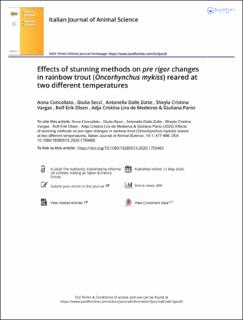| dc.contributor.author | Concollato, Anna | |
| dc.contributor.author | Secci, Giulia | |
| dc.contributor.author | Zotte, Antonella Dalle | |
| dc.contributor.author | Vargas, Sheyla Cristina | |
| dc.contributor.author | Olsen, Rolf Erik | |
| dc.contributor.author | Lira de Medeiros, Adja Cristina | |
| dc.contributor.author | Parisi, Giuliana | |
| dc.date.accessioned | 2021-02-16T11:15:34Z | |
| dc.date.available | 2021-02-16T11:15:34Z | |
| dc.date.created | 2020-09-17T16:57:43Z | |
| dc.date.issued | 2020 | |
| dc.identifier.citation | Italian Journal of Animal Science. 2020, 19 (1), 477-486. | en_US |
| dc.identifier.issn | 1594-4077 | |
| dc.identifier.uri | https://hdl.handle.net/11250/2728334 | |
| dc.description.abstract | The effects of two stunning methods (carbon monoxide asphyxia, CO, and electroshock, E) on blood plasma parameters, rigor index, fillet pH and shape changes, ATP breakdown and Adenylate Energy Charge (AEC) in muscle immediately post mortem were investigated in rainbow trout (Oncorhynchus mykiss) kept in tanks containing water set at 8 °C or 12 °C. Both the methods here adopted induced a stress-response which, however, was not able to affect the rigor mortis development and fillet pH. The fillets from the E group showed the strongest length contraction and width increase at 48 h post mortem. The CO stunning method exhibited the highest levels of both ATP and AEC in the muscle immediately after death, equal to 2.28 µmol/g and 0.83, respectively, while 1.12 µmol/g and 0.64 values were found in the E group. In addition, we found that the water temperature might interact with the stunning method and minimise the stress response. In the present trial, the most suitable use of the CO stunning method would be coupled with 12 °C of rearing water temperature to better preserve ATP and AEC in muscles. | en_US |
| dc.language.iso | eng | en_US |
| dc.title | Effects of stunning methods on pre rigor changes in rainbow trout (Oncorhynchus mykiss) reared at two different temperatures | en_US |
| dc.type | Peer reviewed | en_US |
| dc.type | Journal article | en_US |
| dc.description.version | publishedVersion | en_US |
| dc.source.pagenumber | 477-486 | en_US |
| dc.source.volume | 19 | en_US |
| dc.source.journal | Italian Journal of Animal Science | en_US |
| dc.source.issue | 1 | en_US |
| dc.identifier.doi | 10.1080/1828051X.2020.1759465 | |
| dc.identifier.cristin | 1830960 | |
| cristin.ispublished | true | |
| cristin.fulltext | original | |
| cristin.qualitycode | 1 | |
